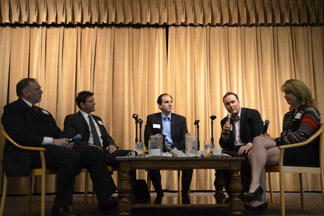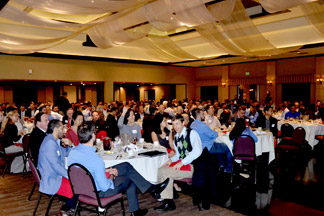LONG BEACH (January 21, 2014) – Two hundred-plus attendees gathered on Tuesday, Jan. 21, at the Long Beach Grand for the 2014 Industry Forecast luncheon hosted by the Association of Corporate Real Estate Executives (ACRE) of Southern California. The panel, moderated by Progressive Real Estate Partners President Brad Umansky, covered the state of the Southern California retail real estate market and expectations for 2014.

Panelists included Greg Fisher, President of Present Value Properties; Rick Rivera, President of Centers Business Management (CBM); Shauna Mattis, Senior Vice President of Wilson Commercial Real Estate (WCRE); and Matt Hammond, Coreland Companies Director of Retail Brokerage.
All were in agreement to start the discussion: “2013 was an outstanding year for our team. We have more than tripled our business since 2007,” shared Fisher.
The ‘flight to quality’ continues as national tenants are focusing on centers with the best positioning, best visibility and highest traffic counts. However, Rivera contends that CBM’s “business has remained steady” throughout the last three years due to portfolio diversity:
“Representing smaller shopping centers in less desirable locations that don’t demand ‘top rents’ has allowed us to continue writing new leases, thus we’ve consistently increased our volume year-over-year.”
 When asked to identify surprises in today’s market, Hammond shared that while “tenant’s sales are getting stronger and there’s an appetite to grow due to low cap rates, there is still a disconnect between what an owner needs in rent to make a deal pencil, and what the market will bear.”
When asked to identify surprises in today’s market, Hammond shared that while “tenant’s sales are getting stronger and there’s an appetite to grow due to low cap rates, there is still a disconnect between what an owner needs in rent to make a deal pencil, and what the market will bear.”
Noting that the local retail landscape has historically been heavily reliant on the success of grocery store anchor tenants, Umansky asked the panel to share concepts that seem to be working.
“Hispanic retailers are doing a fabulous job of servicing their customers, and stores such as Vallarta and El Super have been very successful at it,” shared Fisher. “However, I expect there to be a shake-out in the grocery business because there is a shrinking pie that is being sliced into too many pieces.”
“Where it used to be that the traditional grocery stores attracted tenants to a center, we are now seeing that specialty grocers are the stronger draw,” said Hammond. “Specialty grocers know their target customer so well, which in turn benefits shop tenants considering leasing space.
Throughout the discussion panelists identified that the retail landscape has changed to become destination-focused and service-oriented. Per statistics shared by Hammond, more than two-thirds of leases signed in 2013 were with restaurants/QSRs or service tenants – things you can’t do online.
“What I have enjoyed most are the new entertainment concepts that we have been able to bring to our properties,” said Mattis. “We recently added a roller skating rink to one of our centers in Murrieta.” They opened last month and there have been lines out the door ever since. Entertainment continues to be a great way to drive traffic.”
“Certainly the Internet has changed retail. But if you have a property with good visibility and strong demographics, there is always going to be a new tenant with a new retail concept to fill space,” shared Rivera.
Panelists closed by commenting on the opportunities and challenges that lie ahead.
“Finding supply is our biggest challenge so we have to create opportunities to find good space,” shared Hammond. “We must help our clients reposition existing centers in order to be competitive in the marketplace.”
“The retail market is constantly changing, and in many ways it has become more of a service business,” closed Umansky. “But change is the thing I love most about our business. It is always evolving and there is always opportunity.”
# # #

